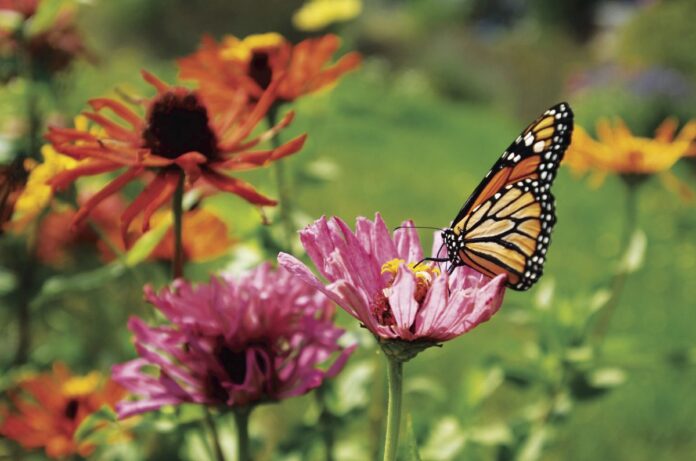By Lori Murray and Mary Beth Simmons, Cameron County Master Gardener, Texas Certified Nursery Professional
Lantana is an easy to grow plant which butterflies love. It will grow in our hot Valley sun and is salt and drought tolerant. Its flowers begin in spring and continue until cold weather sets in. Lantana can grow to a height of one to three feet and blooms in clusters of tiny bright yellow, orange, red, lavender, white or multicolored flowers.
Some varieties are bushy and upright while others have a trailing habit. They are dense enough to fill in an area (space one to two feet apart) and can be lightly pruned to keep a desired shape and size. An added advantage is that their density helps keep weeds out. Although lantana will grow in dry conditions, it will do better and bloom more profusely when watered.
Butterfly weed (Asclepias curassavica) is a fast growing plant that grows about two feet tall. An annual in some climates, it is more of a perennial here, reseeding itself or coming back each year. Flowers are in compact clusters at the top of the stems. The blooms are yellow with reddish orange hoods or a solid bright yellow. The slender, pointed leaves form opposite each other.
The plant prefers full sun with adequate moisture but will tolerate some light shade. Wilting leaves alert you when it needs water. It blooms from April through October. If a plant gets too leggy, it can be trimmed back after the blooms fade; it will bush and bloom again.
Other butterfly plants include penta and Blue Mist spirea which tends to be invasive and should be planted where it can be restricted. Turk’s Cap, Vitex, Jatropha, Caesalpinia. Mexican Bush Sage, Plumbago, Salvia, and Mountain Laurel are yet others that attract butterflies to the garden.
Remember that butterflies are first caterpillars and will eat the leaves of the host plant, so be sure that you do not use pesticide in their area. Butterfly weed will serve as a host plant as well as a nectar plant, and common dill will also provide food for the hungry caterpillars. More possibilities of both nectar and host plants will be featured periodically in future articles.
ATTRACTING BUTTERFLIES TO YOUR GARDEN
In Part One, you learned the needs of butterflies. Listed below are plants that do well in the Valley and will draw butterflies to your yard and keep them there. Remember that you need to have not only nectar plants to lure butterflies to your garden, but also host plants to feed the caterpillars that become the next generation. Nectar plants should be planted in the sun, but host plants can be planted in the sun or shade.
Butterfly Nectar Flowers for the RGV
NAME – FLOWER – BLOOM
*Betony mistflower, Conoclinium betonicifolium – Blue – Nearly all year
*Crucita, mistflower, Chromalaena odorata – Blue – Fall
*Wild olive, anacahuita, Cordia boissieri – White – Nearly all year
*Texas lantana, Lantana urticoides – Red, yellow, orange – Nearly all year
*White brush, Aloysia gratissima – White – Nearly all year
*Mexican buttonbush, Cephalanthus salicifolius – White – Spring – summer
*Velvet-leaf lantana, Lantana velutina – White – Year round
Duranta, Duranta erecta – Blue, white, purple – Spring – fall
Gregg’s mistflower, Eupatorium greggii – Bluish purple – Spring – fall
*Frogfruits, Phyla strigulosa, incise – White – Nearly all year
*Taperleaf heliotrope, Heliotropium angiospermum – White – Nearly all year
*Spring mistflower, Eupatorium azureum – Blue – Winter – spring
*Crotons, Croton humilis, cortez – Cream – Nearly all year
*Hairy wedelia, zexmenia, Wedelia texana – Yellow – Nearly all year
*White plumbago, Plumbago scandens – White – Fall
*White mistflower, Fleishmannia incarnate – White – Fall
*Turk’s Cap, Malvaviscus drummondii – Red – Nearly all year
Tropical (Mexican) milkweed, Asclepias curassavica – Red & yellow – Spring – fall
*Mexican trixis, Trixis inula – Yellow – Nearly all year
*Bush sunflower, Simsia calva – Yellow – Nearly all year
*Shrubby blue sage, Salvia ballotiflora – Bluish-purple – After rain
*Skeleton leaf daisy, Viguera stenoloba – Yellow – Spring-fall
Caterpillar Food Plants for the RGV
NAME – CATERPILLAR
*Blue passionvine, Passiflora foetida – Gulf fritillary
*Corky stem passionvine, Passiflora suberosa – Gulf fritillary, Mexican silverspot
*Cowpen daisy, Verbesina encelioides – Bordered patch
*Turk’s Cap, Malvaviscus drummondii – Turk’s cap white skipper
Tropical (Mexican) milkweed, Asclepias curassavica – Monarch, queen
*Ruellia, wild petunia, Ruellia nudiflora – Malachite, white peacock
*Texas torchwood, Amyris texana – Giant swallowtail
*Texas kidneywood, Eysenhardtia texana – Southern dogface
*Sugar hackberry, Celtis laevigata – Emperors, snout
*Vasey adelia, Adelia vaseyi – Mexican bluewing
*Frogfruits, Phyla strigulosa, incise – White peacock
*Crotons, Croton humilis, cortez – Tropical, goatweed, leafwings
Guamuchil, Pithecellobium dulce – Red-bordered pixie, large orange sulfer
Guava, Psidium guajava – Guava skipper
*Heart leaf hibiscus, Hibiscus martianus – Mallow-scrub hairstreak, gray hairstreak
*Barbados cherry, mazanita, Xylosma flexuosa – White-patched skipper
*Texas baby bonnets, Coursetia axillaris – Southern dogface, funereal duskywing
*Prairie milkweed, Asclepias oenotheroides – Monarchs and mimics
*White plumbago, Plumbago scandens – Marine blue, cassius blue
Flame acanthus, Anisacanthus wrightii – Crimson patch
*designates native plant
List from North American Butterfly Association, South Texas





